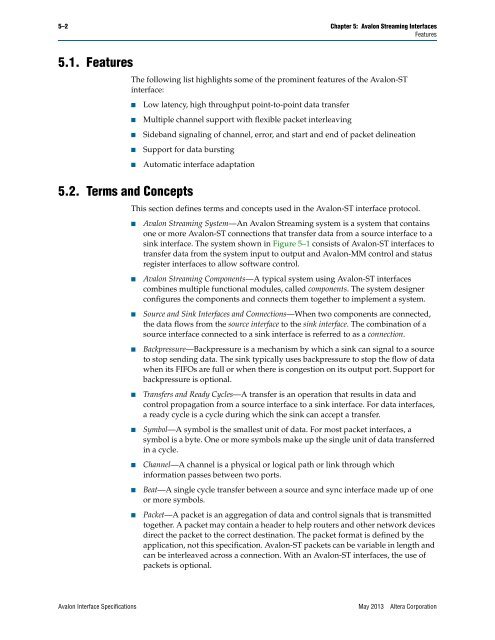Avalon Interface Specifications (PDF) - Altera
Avalon Interface Specifications (PDF) - Altera
Avalon Interface Specifications (PDF) - Altera
You also want an ePaper? Increase the reach of your titles
YUMPU automatically turns print PDFs into web optimized ePapers that Google loves.
5–2 Chapter 5: <strong>Avalon</strong> Streaming <strong>Interface</strong>s<br />
Features<br />
5.1. Features<br />
The following list highlights some of the prominent features of the <strong>Avalon</strong>-ST<br />
interface:<br />
■ Low latency, high throughput point-to-point data transfer<br />
■ Multiple channel support with flexible packet interleaving<br />
■ Sideband signaling of channel, error, and start and end of packet delineation<br />
■ Support for data bursting<br />
■ Automatic interface adaptation<br />
5.2. Terms and Concepts<br />
This section defines terms and concepts used in the <strong>Avalon</strong>-ST interface protocol.<br />
■ <strong>Avalon</strong> Streaming System—An <strong>Avalon</strong> Streaming system is a system that contains<br />
one or more <strong>Avalon</strong>-ST connections that transfer data from a source interface to a<br />
sink interface. The system shown in Figure 5–1 consists of <strong>Avalon</strong>-ST interfaces to<br />
transfer data from the system input to output and <strong>Avalon</strong>-MM control and status<br />
register interfaces to allow software control.<br />
■ <strong>Avalon</strong> Streaming Components—A typical system using <strong>Avalon</strong>-ST interfaces<br />
combines multiple functional modules, called components. The system designer<br />
configures the components and connects them together to implement a system.<br />
■ Source and Sink <strong>Interface</strong>s and Connections—When two components are connected,<br />
the data flows from the source interface to the sink interface. The combination of a<br />
source interface connected to a sink interface is referred to as a connection.<br />
■ Backpressure—Backpressure is a mechanism by which a sink can signal to a source<br />
to stop sending data. The sink typically uses backpressure to stop the flow of data<br />
when its FIFOs are full or when there is congestion on its output port. Support for<br />
backpressure is optional.<br />
■ Transfers and Ready Cycles—A transfer is an operation that results in data and<br />
control propagation from a source interface to a sink interface. For data interfaces,<br />
a ready cycle is a cycle during which the sink can accept a transfer.<br />
■ Symbol—A symbol is the smallest unit of data. For most packet interfaces, a<br />
symbol is a byte. One or more symbols make up the single unit of data transferred<br />
in a cycle.<br />
■ Channel—A channel is a physical or logical path or link through which<br />
information passes between two ports.<br />
■ Beat—A single cycle transfer between a source and sync interface made up of one<br />
or more symbols.<br />
■ Packet—A packet is an aggregation of data and control signals that is transmitted<br />
together. A packet may contain a header to help routers and other network devices<br />
direct the packet to the correct destination. The packet format is defined by the<br />
application, not this specification. <strong>Avalon</strong>-ST packets can be variable in length and<br />
can be interleaved across a connection. With an <strong>Avalon</strong>-ST interfaces, the use of<br />
packets is optional.<br />
<strong>Avalon</strong> <strong>Interface</strong> <strong>Specifications</strong> May 2013 <strong>Altera</strong> Corporation
















